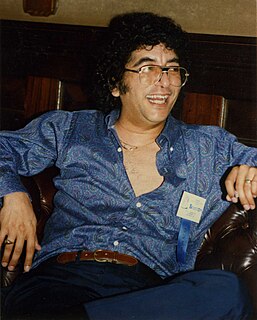
Robert Lynn Asprin was an American science fiction and fantasy author and active fan, known best for his humorous series MythAdventures and Phule's Company.

Thebes is a city in Boeotia, Central Greece. It played an important role in Greek myths, as the site of the stories of Cadmus, Oedipus, Dionysus, Heracles and others. Archaeological excavations in and around Thebes have revealed a Mycenaean settlement and clay tablets written in the Linear B script, indicating the importance of the site in the Bronze Age.

Thebes, known to the ancient Egyptians as Waset, was an ancient Egyptian city located along the Nile about 800 kilometers (500 mi) south of the Mediterranean. Its ruins lie within the modern Egyptian city of Luxor. Thebes was the main city of the fourth Upper Egyptian nome and was the capital of Egypt for long periods during the Middle Kingdom and New Kingdom eras. It was close to Nubia and the Eastern Desert, with its valuable mineral resources and trade routes. It was a cult center and the most venerated city during many periods of ancient Egyptian history. The site of Thebes includes areas on both the eastern bank of the Nile, where the temples of Karnak and Luxor stand and where the city was situated; and the western bank, where a necropolis of large private and royal cemeteries and funerary complexes can be found. In 1979, the ruins of ancient Thebes were classified by UNESCO as a World Heritage Site.

Boeotia, sometimes Latinized as Boiotia or Beotia, formerly known as Cadmeis, is one of the regional units of Greece. It is part of the region of Central Greece. Its capital is Livadeia, and its largest city is Thebes.
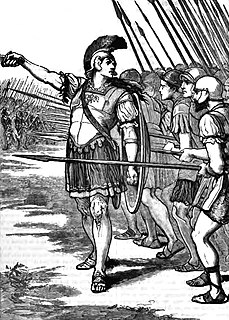
The Battle of Leuctra was a battle fought on 6 July 371 BC between the Boeotians led by the Thebans, and the Spartans along with their allies amidst the post-Corinthian War conflict. The battle took place in the neighbourhood of Leuctra, a village in Boeotia in the territory of Thespiae. The Theban victory shattered Sparta's immense influence over the Greek peninsula, which Sparta had gained with its victory in the Peloponnesian War a generation earlier.
The Sacred Band of Thebes was a troop of select soldiers, consisting of 150 pairs of male lovers which formed the elite force of the Theban army in the 4th century BC, ending Spartan domination. Its predominance began with its crucial role in the Battle of Leuctra in 371 BC. It was annihilated by Philip II of Macedon in the Battle of Chaeronea in 338 BC.
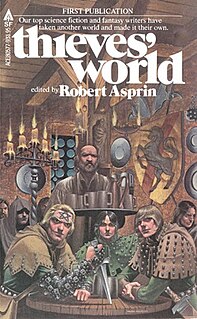
Thieves' World is a shared world fantasy series created by Robert Lynn Asprin in 1978. The original series comprised twelve anthologies, including stories by science fiction authors Poul Anderson, John Brunner, Andrew J. Offutt, C. J. Cherryh, Janet Morris, and Chris Morris.
Homosexuality in the militaries of ancient Greece was regarded as contributing to morale. Although the primary example is the Sacred Band of Thebes, a unit said to have been formed of same-sex couples, the Spartan tradition of military heroism has also been explained in light of strong emotional bonds resulting from homosexual relationships. Various ancient Greek sources record incidents of courage in battle and interpret them as motivated by homoerotic bonds.

In classical antiquity, writers such as Herodotus, Plato, Xenophon, Athenaeus and many others explored aspects of homosexuality in Greek society. The most widespread and socially significant form of same-sex sexual relations in ancient Greece amongst elite circles was between adult men and pubescent or adolescent boys, known as pederasty. Nevertheless, homosexuality and its practices were still wide-spread as certain city-states allowed it, while others were ambiguous or prohibited it. Though sexual relationships between adult men did exist, it is possible at least one member of each of these relationships flouted social conventions by assuming a passive sexual role according to Kenneth Dover, though this has been questioned by recent scholars. It is unclear how such relations between same-sex partners were regarded in the general society, especially for women, but examples do exist as far back as the time of Sappho.

Orchomenus, the setting for many early Greek myths, is best known today as a rich archaeological site in Boeotia, Greece, that was inhabited from the Neolithic through the Hellenistic periods. It is often referred to as "Minyan Orchomenus", to distinguish it from a later city of the same name in Arcadia.
Tempus is a Latin word meaning time and a Finnish, Swedish and German word meaning grammatical tense. It may refer to:
The Order of Chaeronea was a secret society for the cultivation of a homosexual moral, ethical, cultural and spiritual ethos. It was founded by George Cecil Ives in 1897, as a result of his belief that homosexuals would not be accepted openly in society and must therefore have a means of underground communication.
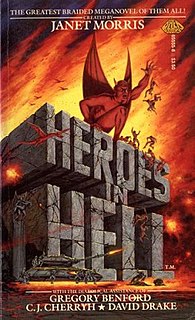
Heroes in Hell is a series of shared world fantasy books, within the genre Bangsian fantasy, created and edited by Janet Morris and written by her, Chris Morris, C. J. Cherryh and others. The first 12 books in the series were published by Baen Books between 1986 and 1989, and stories from the series include one Hugo Award winner and Nebula nominee, as well as one other Nebula Award nominee. The series was resurrected in 2011 by Janet Morris with the thirteenth book and eighth anthology in the series, Lawyers in Hell, followed by eight more anthologies and four novels between 2012 and 2022.
Janet Ellen Morris is an American author of fiction and nonfiction, best known for her fantasy and science fiction and her authorship of a non-lethal weapons concept for the U.S. military.
Robin Wayne Bailey is an American writer of speculative fiction, both fantasy and science fiction. He is a founder of the Science Fiction Hall of Fame (1996) and a past president of the Science Fiction and Fantasy Writers of America.
Christopher Crosby Morris is an American author of fiction and non-fiction, as well as a lyricist, musical composer, and singer-songwriter. He is married to author Janet Morris. He is a defense policy and strategy analyst and a principal in M2 Technologies, Inc. He writes primarily as Chris Morris, a shortened form of his name, but occasionally uses pseudonyms.

Tempus With His Right Side Companion Niko is a novelized collection of fourteen previously-published short stories in the Sacred Band series by Janet Morris. Originally published in 1987 by Baen, it was reissued in 2011 by Paradise Publishing.

Tales from the Vulgar Unicorn is an anthology of fantasy stories edited by Robert Lynn Asprin and published in 1980. It is the second in the Thieves' World series, featuring stories by a variety of authors with the common setting of Sanctuary, a city at the far southern corner of the empire where all the less-than-law-abiding citizens of the world tend to congregate.
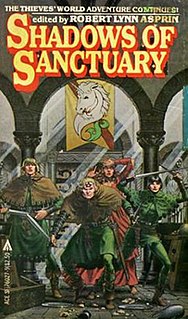
Shadows of Sanctuary is a short story collection edited by Robert Lynn Asprin and published in 1981. It is the third in the Thieves' World anthology series.












